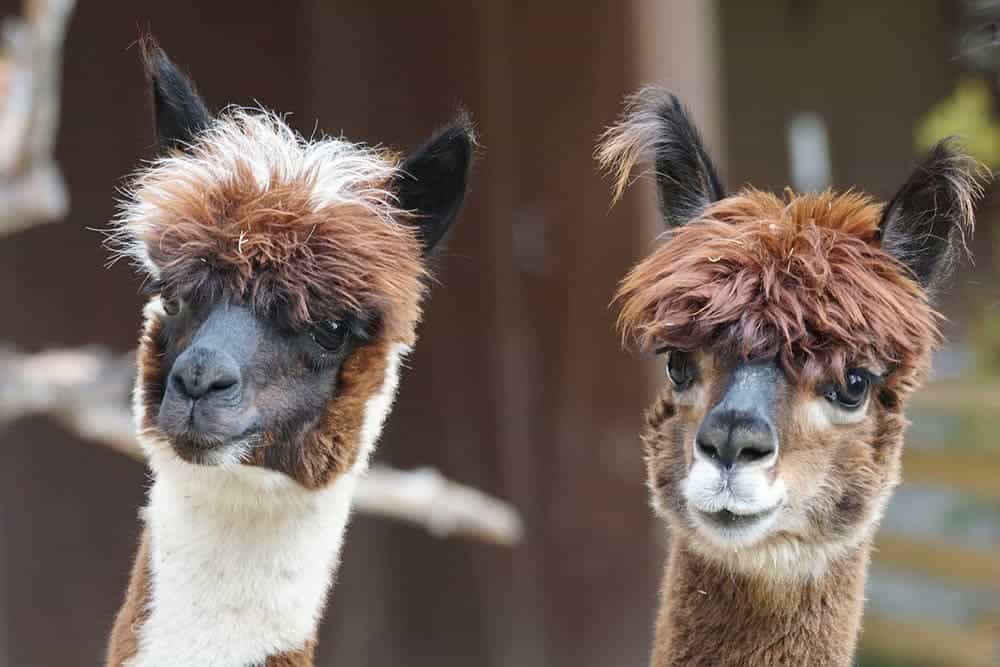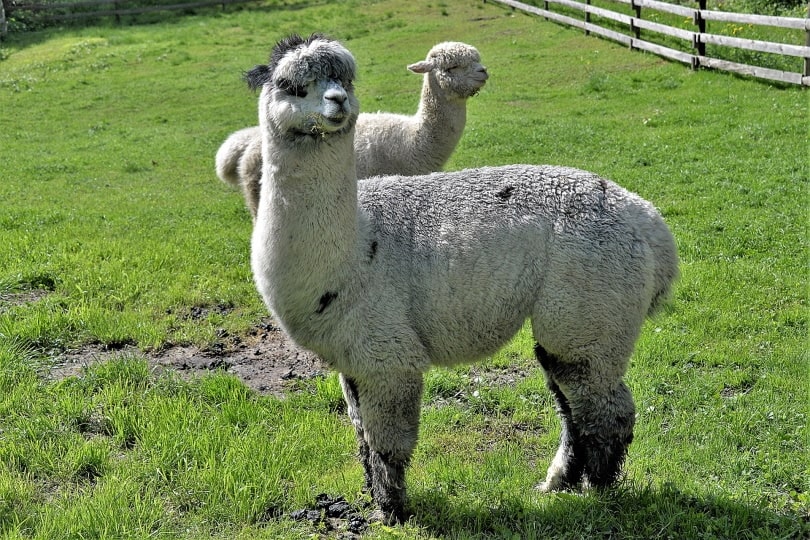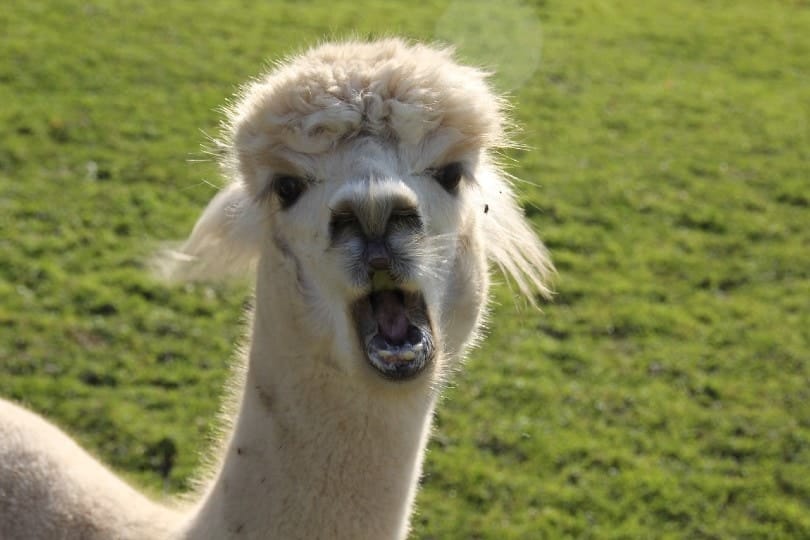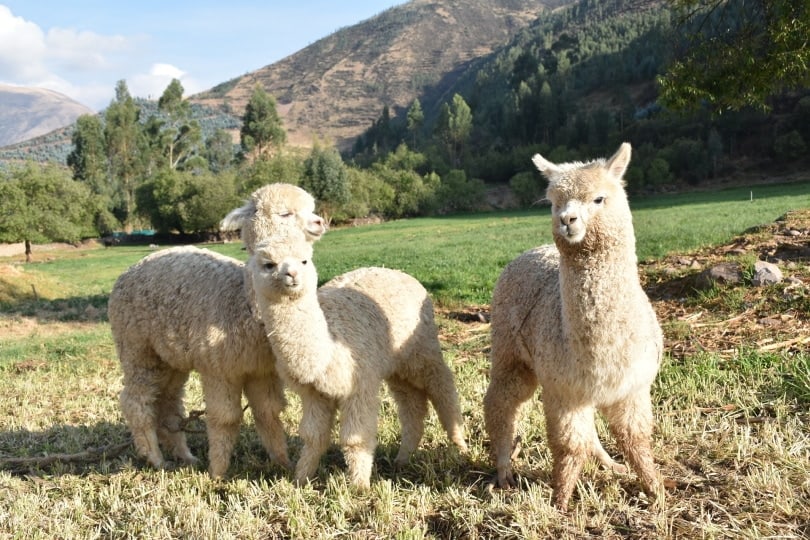Alpacas are hardy animals. They don’t require as much care as you might think.
Alpacas can take many different roles on your farm. They produce fleece, which can be sold. There is not a huge fleece market in the U.S.A., but it is always growing. Their fleece is higher quality than sheep fleece and hypoallergenic.
In the U.S., alpacas are mostly bred, shown, and then sold. You can participate in this market with ease because these animals breed easily.
For everything that you need to know about alpaca care, keep reading.
Click to Skip Ahead:

Types of Alpacas
There are two main types of alpacas. If you decide to bring this animal onto your homestead, you’ll need to figure out which breed to purchase. Both require similar care. However, they do have slight differences.
- Huacaya: About 90% of all domestic alpacas fall into this category. They are fluffy and have soft fleece, so they are mostly used for their wool. They are likely what you typically know as the alpaca.
- Suri: A small number of alpacas come from this breed. They are known for their fine wool, which creates soft and delicate fabric. They have long, shiny fleece that is a bit higher quality than some other options.

Grooming
Alpacas need to be sheared at least once a year. They have been bred to overgrow their wool. Therefore, they produce far more wool than you might expect. If you do not shear them, they will have difficulty moving.
Often, they are sheared at the end of winter so they are not as miserable during the summer.
Their toenails should be trimmed every 2–4 months. Otherwise, foot problems can develop.
Training
Alpacas are much easier to take care of with basic training. They are smart, so this is relatively easy. If you start training them when they are young, it is even easier. You’ll want to put a halter on them as soon as possible and teach them to be led with a rope. In the future, when they are bigger, this will make your life much easier.
You’ll want to teach your alpaca to be transported. Otherwise, trying to transport them during a medical emergency will be extremely dangerous and difficult, especially since the animal will be substantially stressed.
Typically, if you usher your alpaca into a small space, they will lay down in the “cush” position, making them easy to transport. Therefore, putting them in the bed of a truck or SUV is often all that you need to do.

Space
You don’t need much space to raise alpacas. In fact, you typically can keep three to five animals on one acre, depending on the level of vegetation in the area.
Alpacas are herd animals, so you cannot keep them alone. However, you can keep many of them in small spaces, so adopting more than one is often not a huge issue.
You can keep most of them in wooded areas where there is thick underbrush, as they can eat plants of all sorts. In the winter, you’ll need to provide a small amount of hay. However, these animals do not eat much at all, so it usually only takes about half a ton per animal to get them through the winter season.
If you don’t have a wooded area, you can keep them in a field and feed them hay. However, this will obviously cost more money because the animals will not be grazing much.
Nutrition
You can provide these animals with hay during the winter. During the other seasons, they can graze in wooded areas without much of a problem. They are good at what they do and are generally considered easy keepers.
You should feed them grass hay, not alfalfa. This sort of hay is too rich in protein and can cause issues with alpacas. They have one stomach that is divided into three parts, which enables them to get everything that they need from grass hay.
Nutritional supplements are helpful for pregnant and nursing alpacas. You can talk to your vet about specific vitamins that your alpaca may need more of.

Shelter
Alpacas do not need much shelter in the least. They do great in a barn, but even this is not always necessary. A lean-to shelter may be all that they need, just to escape from the rain.
You should not house them with goats and sheep. They do not have long tongues, so they cannot strip pastures bare like these animals. They cannot survive on grazing pastures for this reason. If you keep them with goats and sheep, they will have an even harder time. Alpacas can only nibble on the tops of the grass, while the other species can pull it out by the roots. Therefore, they will find it difficult to get food in these situations.
They can also have a hard time defending themselves from more aggressive animals. They only have two sets of back teeth, while most other animals typically have more. They literally cannot bite, so they cannot fight other animals.
They also don’t have hard hooves for kicking. They may try to kick if they are provoked, but they can’t do all that much damage, especially compared to most other hooved animals.

What About Spitting and Aggression?
Many people are worried about alpacas spitting. However, alpacas only tend to spit on other alpacas. Since they cannot bite, these animals spit instead. They usually do not spit on people. However, people may be spit at when they find themselves in between two of these animals. The best advice is to not stand between them!
That said, alpacas can be useful as guard animals in some cases. They don’t have significant ways to defend themselves, but their powerful legs are effective against small animals like raccoons and foxes.
However, it is typically best to have some sort of fencing around your alpacas. You don’t have to worry about keeping alpacas in most cases, as they tend to respect fencing. However, you will need to keep larger predators out that they cannot defend against. A horse fence is often adequate for alpacas if it is 5 to 6 feet tall.
They may be known for spitting and their territorial nature, but they cannot defend themselves against larger predators.

Keeping Llamas With Alpacas
Alpacas and llamas are closely related. Therefore, many people want to keep them together. However, these are different animals and need to be treated differently if you want the best for both of them.
First, these species can interbreed but they produce sterile offspring. If they interbred too much, like what would happen in an uncontrolled herd, then all your animals will eventually be sterile.
Second, llamas are much larger than alpacas. They can bully alpacas and prevent them from accessing food and shelter. Alpacas don’t stand a chance against these larger animals.
Finally, there is a large temperament difference between these two animals. Alpacas are much calmer and easygoing than llamas, which are known for their ill-tempered nature. Therefore, not only can they harm alpacas, but they also absolutely will.

Conclusion
Taking care of alpacas is not that difficult. They are best when kept by themselves or with poultry, as they do not get along with bigger animals. They are easygoing animals with little way to defend themselves against llamas, sheep, or goats.
You can keep many alpacas in a small area because they do not require much grazing land or room. It typically doesn’t take much room to keep them by themselves.
When placed in a wooded area with plenty of foliage, you typically don’t have to worry about feeding alpaca. However, their diet will need to be supplemented in the winter with grass hay. But they don’t require much feed. One alpaca can be sustained on half a ton of hay in most seasons.
Overall, these animals are surprisingly easy to care for. They can produce high-quality wool on little feed.
Featured Image Credit: Götz Friedrich, Pixabay
